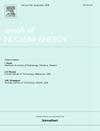用于一般生物圈评估的农作物放射性核素浓度新数学模型
IF 1.9
3区 工程技术
Q1 NUCLEAR SCIENCE & TECHNOLOGY
引用次数: 0
摘要
为支持韩国深层地质储存库的通用安全评估,开发了农作物中放射性核素浓度的新数学模型。它是通过反映国内农业实践,如土地利用、收获和施肥、灌溉方法和食品加工而开发的。采用一种新的方法对灌溉期和灌溉期结束至收获期两种类型的作物表面的外部污染物进行了分析。考虑到作物中的放射性核素浓度对动物产品中的放射性核素浓度的重大影响以及井水耕作情景的总暴露剂量,所开发的数学模型可以支持更现实的安全评估和开发深部地质储存库的安全案例。此外,采用的分离风化期方法有望为考虑气候变化的灌溉期变化提供灵活性。本文章由计算机程序翻译,如有差异,请以英文原文为准。
A new mathematical model for the radionuclide concentrations in crops for the generic biosphere assessment
A new mathematical model for radionuclide concentrations in crops is developed to support a generic safety assessment for a deep geological repository in Korea. It is developed by reflecting domestic agricultural practices such as land use, harvest and fertilization, irrigation method, and food processing. A new approach is applied to the external contaminants on crop surfaces during two types of periods such as the irrigation period and the period from the end of the irrigation period to the harvest. Considering the significant impacts of radionuclide concentrations in crops to those in animal products and total exposure doses for the well water farming scenario, the mathematical model developed can support a more realistic safety assessment and the development of a safety case for the deep geological repository. In addition, the separated weathering duration approach adopted is expected to provide flexibility for the changes in the irrigation period considering climate change.
求助全文
通过发布文献求助,成功后即可免费获取论文全文。
去求助
来源期刊

Annals of Nuclear Energy
工程技术-核科学技术
CiteScore
4.30
自引率
21.10%
发文量
632
审稿时长
7.3 months
期刊介绍:
Annals of Nuclear Energy provides an international medium for the communication of original research, ideas and developments in all areas of the field of nuclear energy science and technology. Its scope embraces nuclear fuel reserves, fuel cycles and cost, materials, processing, system and component technology (fission only), design and optimization, direct conversion of nuclear energy sources, environmental control, reactor physics, heat transfer and fluid dynamics, structural analysis, fuel management, future developments, nuclear fuel and safety, nuclear aerosol, neutron physics, computer technology (both software and hardware), risk assessment, radioactive waste disposal and reactor thermal hydraulics. Papers submitted to Annals need to demonstrate a clear link to nuclear power generation/nuclear engineering. Papers which deal with pure nuclear physics, pure health physics, imaging, or attenuation and shielding properties of concretes and various geological materials are not within the scope of the journal. Also, papers that deal with policy or economics are not within the scope of the journal.
 求助内容:
求助内容: 应助结果提醒方式:
应助结果提醒方式:


